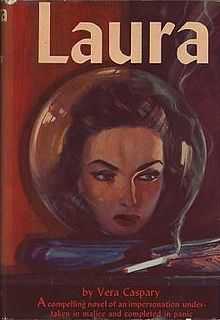Laura (novel)
 First edition | |
| Author | Vera Caspary |
|---|---|
| Original title | Ring Twice for Laura (serial title) |
| Country | United States |
| Language | English |
| Genre | Mystery novel |
| Publisher | Colliers, 1942 (serial); Houghton Mifflin, 1943 (book). |
Publication date | 1942, 1943 |
| Pages | 237 (Houghton Mifflin edition) |
Laura (1942, 1943) is a detective novel by Vera Caspary. It is her best known work, and was adapted into a popular film in 1944, with Gene Tierney in the title role.
Publication history
Originally, Laura ran in Colliers from October to November 1942 as a seven-part serial entitled Ring Twice for Laura. Houghton Mifflin republished Laura in book form the next year; afterwards, Caspary sold the film rights to Twentieth Century Fox, resulting in a 1944 hit movie starring Gene Tierney and Dana Andrews. In 1946, Caspary sold the story for a fourth time, this time co-writing a theatrical version with George Sklar.[1]
Laura achieved an international readership and has been translated into German, Italian, Japanese and Dutch. Since its original publication, the novel has been reissued many times. I Books released an edition in 2000, billing it as a "lost classic." Although this is now out of print, a Feminist Press edition became available in 2006.
Plot introduction
Like Wilkie Collins' detective novel The Moonstone (1868), Laura is narrated in the first person by several alternating characters.[2] These individual stories all revolve around the apparent murder of the title character, a successful New York advertiser killed in the doorway of her apartment with a shotgun blast that obliterated her face.
Detective Mark McPherson, assigned to the case, begins investigating the two men who were closest to Laura: her former lover, a narcissistic middle-aged writer named Waldo Lydecker, and her fiance, the philandering Shelby Carpenter. As he learns more about Laura, Mark – not the most sentimental of men – begins to fall in love with her memory. When Laura turns out to be very much alive, however, she becomes the prime suspect.
The novel has some autobiographical elements; Caspary, like Laura, was an independent woman who earned her living as an advertiser and who struggled to balance career and romance.[3]
Major characters
- Laura Hunt, a smart and beautiful New York advertiser whose career is thriving.
- Mark McPherson, the young homicide detective assigned to the Laura Hunt (later the Diane Redfern) murder case.
- Waldo Lydecker, an obese middle-aged writer with expensive tastes; Laura's former lover.
- Shelby Carpenter, Laura's fiance, an undistinguished philanderer.
- Diane Redfern, a struggling young model; the actual murder victim.
Excerpt
Laura recalls the day she discovered her fiance's infidelity with a young model named Diane Redfern.
| “ | Desperate, my mother used to say, I'm desperate, when she locked herself in her bedroom with a sick headache. I always envied her; I wanted to grow up and be desperate too. On Friday afternoon, as I walked up and down my office, I whispered it over and over. Desperate, desperate, at last I'm desperate, I said, as if the word were consummation. I can see the office now, the desk and filing-case and a proof of a Lady Lilith color ad with Diane lying backward on a couch, head thrown back, breasts pointed upward like small hills. I feel, rather than smell, the arid, air-conditioned atmosphere, and I tense my right hand as if the letter-opener were still cutting a ridge across my palm. I was sick, I was desperate, I was afraid. I hid my face in my hands, my forehead against the wood of my desk. Laura, Part 4, Chapter II. |
” |
Discussion
Laura is often identified, erroneously, as a noir novel, and the lead character as a femme fatale. Laura Hunt, true, is smart, independent, beautiful and desirable; she has discarded the effete Waldo Lydecker to marry Shelby Carpenter; the body of Shelby's lover is found in her apartment, wearing her clothes; and, when questioned, she answers evasively.
All these things throw suspicion on her; nonetheless, the plot's main tendency is to show that while circumstances have pushed Laura dangerously close to emotional chaos, she has more innate integrity than every other character in the novel, male or female: Laura's fiance, for example, is unfaithful to her even on the eve of their wedding, while her "best friend" Waldo uses insidious methods to drive her lovers away. Morally, Laura's only equal is Mark McPherson, the hardboiled detective who begins by investigating Laura's murder; then investigates Laura for murder; and finally becomes her true love and savior.
The falsely impugned heroine, her rescue by her lover, and the happy ending put Laura solidly in the romantic suspense genre. What sets it apart is that Laura is no helpless virgin: she has a successful career and a considerable sexual history, but still emerges as sincere and lovable, with domestic urges so strong that she is prepared to marry an unworthy man to fulfill them.[4]
References
- ↑ Hamache, Arezki. "Laura: Otto Preminger" (DVD review). La Factory (website), January 28, 2006. Accessed 7-13-2007 (full text - in French)
- ↑ Hamache, ibid.
- ↑ Biography of Caspary from the New York Times All-Movie Guide
- ↑ Ng, Laura Ellen. "Feminist hardboiled detective fiction as a political protest in the tradition of women proletarian writers of the 1930s" (Dissertation). Morehead State University, January 31, 2005, pp. 112-114. (full text)
Further reading
- McNamara, Eugene. "Laura" as novel, film, and myth. New York: Edwin Mellen Press, 1992.
External links
- The Feminist Press edition of Laura at Amazon (full text)
- The I Books edition at Amazon. (full text).
- A Napa Valley Register review of Dreamweaver Theatre's March 2007 performance of Laura, with background information (full text).